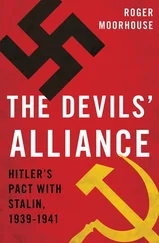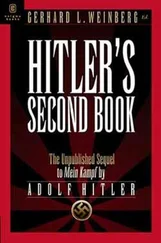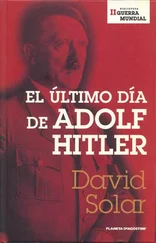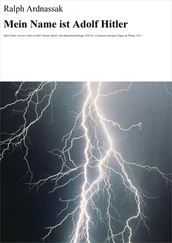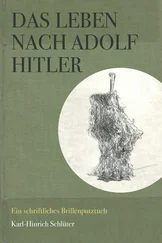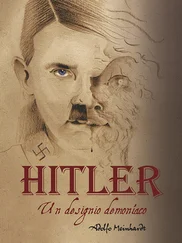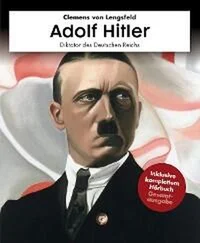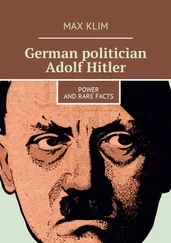Erich Hilgenfeldt (b. 2.7.1899 Heinitz/Ottweiler, fate after 1945 not known). Head of Hauptamt für Volkswohlfahrt (Principal Office for People’s Welfare).
Hitler made a lightning visit to Paris first on 23 June 1940. Architects Speer, Giesler and Breker were with him. Next, on 25 and 26 June 1940, he travelled with First World War comrades Max Amann and Ernst Schmidt to the former German trenches on the Somme.
Signed at Schloss Belvedere, Vienna, on 1 March 1941.
Hitler was in Munich 21–24 March 1941, and in Vienna on 25th, when Yugoslavia joined the Axis. He left immediately afterwards for Berlin, where he arrived on 26th.
See Chapter 11.
Nickname of Wilhelm Brückner.
In a footnote to her papers Schroeder commented: ‘Schaub’. What Schaub had done to merit this note was not recorded.
FHQ Wolfsschanze in the woods at Görlitz was the largest HQ built by the end of 1944. With various absences elsewhere Hitler inhabited this HQ from 24.6.1941 to 20.11.1944 as military overlord. Originally intended for a four-week Blitzkrieg, it was continually expanded until the installations were destroyed on 24.1.1945.
Heinrich Heim (b.15.6.1900 Munich). 1920 NSDAP Membership No. 1222; from 1927 Munich lawyer; 1928◦– end 1930 attorney on staff of Hitler’s lawyer Hans Frank; 1933 staff of Rudolf Hess; various offices at NSDAP; 1940◦– end 1942 Martin Bormann’s adjutant at FHQ (absent 21.3.1942◦– 31.7.1942); 1943 to end April 1945 head of commission in Munich investigating basic questions of law for the reconstituted Europe; 3.5.1945◦– mid 1948 interned.
Henry Daniel Theodor Picker (b. 6.2.1912 Wilhelmshaven, d. 2.5.1988 Starnberg). NSDAP member from 1.4.1930; Hitler Youth Bannführer and Reichsamtleiter to 1.11.1944 when relieved of his post by Hitler and Bormann; deputised for Heinrich Heim at FHQ 21.3.1942◦– 31.7.1942, secretly noting Hitler’s table talks for Bormann. Picker claimed in his book (third edition, 1976) that he was ‘Hitler’s constant guest’ and that Hitler had approved his taking verbatim notes of Hitler’s conversations (p.28). Hermann Giesler: Nachtrag (Heitz & Höffkes Verlag, Düsseldorf 1988, pp.17–18) states however that ‘Picker’s place was at the adjutants’ table and not with the nightly tea guests.’
Werner Jochmann (ed.), Adolf Hitler: Monologe im Führerhauptquartiere 1941–1944: Aufzeichnungen Heinrich Heims , Verlag Albrecht Knaus, Hamburg 1980.
Hitlers Tischgespräche , first published Athenäum Verlag, Bonn 1951, later edition with extensive commentary and notes by Picker, Seewald Verlag, Stuttgart 1976.
14.9.1953 for the BBC, London, taped recording, extract from Klüter-Blättern. Monatshefte für Kultur und Zeitgeschichte , Jahrgang 32, December 1981, Issue 12, p. 29.
Frau von Below, wife of former Luftwaffe adjutant to Hitler Nicolaus von Below (statement by Schroeder to editor).
Otto Günther, 1937 employed on the Führer-train, and then at FHQ. He was on Kannenberg’s staff and cooked for the 150–200 personnel at FHQ Wolfsschanze.
On 26.6.1941 the German 8.Panzer Division captured the bridges over the Duna intact.
Photographer Heinrich Hoffmann and adjutant Richard Schulze.
During a visit to the Eastern Front, Hitler and Mussolini spent the night of 27 August 1941 on their special trains at FHQ Askania-Süd, a purpose-built surface tunnel to house the train coaches near the village of Frysztak in Galicia (tunnel and other structures remain in existence). Barracks for the security personnel and a tea-house for Hitler were located near Strzyzow, twenty kilometres north of Krosno. Seidler and Zeigert, Die Führer-Hauptquartiere , pp. 218–21. (TN)
After dismissing Generalfeldmarschall von Brauchitsch on 19 December 1941, Hitler took over supreme command of the army. He explained: ‘Anybody can handle the little bit of operational leadership. The task of the army supreme commander is to educate the Army to be National Socialist. To my way of thinking there is no army general who can fulfil the role.’
Fritz Todt (b. 4.9.1891 Pforzheim, d. 8.2.1942 Görlitz). From 1939 major general of the Luftwaffe; from 17.3.1940 Reich minister for armament and munitions. After visiting Hitler at FHQ Wolfsschanze on 7 February 1942, he took off in his personal He 111 next morning in adverse weather against advice and crashed on the airfield boundary.
Foreign people = Fremdvolk , i.e. presumably the settled inhabitants of the Ukraine before the Nazis arrived. (TN)
This was SS-Obersturmbannführer Friedrich Darges (b. 8.2.1913 Dülseberg/Altmark). Hitler wanted Darges to marry Eva Braun’s sister Margarete, but Darges preferred Frau von Exner. It is assumed that Hitler was not happy with this arrangement and on 28 July 1944 Darges found himself on the Eastern Front with 5.SS-Panzer Division Wiking; 8.5.1945 interned by US Army; 30.4.1948 released.
Hitler left FHQ Wolfsschanze on 23 February 1944 and remained at the Berghof with short breaks until 14 July 1944, his last day there.
Helene Maria ‘Marlene’ von Exner (b. 16.4.1917 Vienna). 15.7.1943 employed by Hitler; end 1943 Aryan genealogy examined and found defective (Jewish grandmother); 8.5.1944 dismissed from service; Bormann was ordered to ‘arianize’ the family. This was easier done in Austria than Germany and involved juggling old birth certificates to change the line of descent. Frau von Exner survived the war and was living in Austria when this book first appeared in Germany.
Constanze Manziarly (b. 14.4.1920 Innsbruck). Greek father, Austrian mother; September 1944 employed by Hitler as dietician-cook; after April 1945 fate unknown.
Wilhelm Arndt (b. 6.7.1913, d. 22.4.1945). 1944 appointed manservant in rank of SS-Hauptscharführer. He was tall and blue eyed, and Schroeder stated of him that he was Hitler’s favourite valet. Killed when a Ju 352 of the Führer-Staffel from Berlin-Staaken in which he was a passenger crashed at Börnersdorf.
Hitler left FHQ Wolfsschanze on his special train on 20 November 1944. The enemy remained unaware of the location of FHQ Wolfsschanze throughout its period of occupation.
Hitler left Berlin on his special train on 10 December 1944 and returned to Berlin aboard it on 16 January 1945.
Walter Buch mentioned after the war in 1945 that Hitler had told him: ‘The lady I love is called Germania.’
Dr von Hasselbach, one of Hitler’s official surgeons, stated after the war that Hitler had a definite aversion to showing his body, and the doctor had never seen or examined his lower regions.
Heinz Linge, Bis zum Untergang , Werner Maser (ed.), Herbig, Munich-Berlin 1980. Schroeder wrote that she considered Linge’s ‘looking at Hitler’s genitals while he was urinating’ to be a fabrication. ‘What type of wood was it that everybody used the same tree for peeing?’ she asked. ‘Who would have dared to make a point of looking at Hitler’s genitals while he was urinating?’ And in any case: ‘Every man I asked assured me that it would not be possible to catch sight of a man’s testicles in the manner stated.’
Читать дальше

